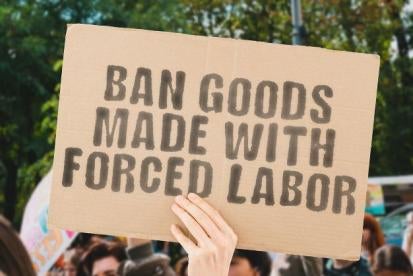Many have viewed corporate commitments to environmental, social, and governance (ESG) as largely performative measures amidst toothless compliance frameworks.1 But this has been changing and we expect that change to continue. One example arises out of the “S” in ESG, particularly expectations for companies to monitor their supply chains to ensure that forced or child labor isn’t employed in the production of their products. The recent and much discussed Uyghur Forced Labor Protection Act, discussed in more detail here and here, is an obvious example of an attempt to enforce these human rights standards.
But there is more: The United States and the European Union have or are proposing real enforcement mechanisms to protect against the sale of goods made using forced labor. In light of this amplified focus on enforcement of these regulations, companies should expect increased scrutiny of their supply chains and prepare for the possibility of government-initiated investigations.
U.S. Law
U.S. law has long allowed the U.S. Customs and Border Protection (CBP) to prevent the entry of goods into the U.S. market that are mined, manufactured, or produced “in whole or in part” in any foreign country by convict, forced, or indentured labor, including forced child labor.2 But the Trade Facilitation and Trade Enforcement Act of 20153 closed existing enforcement loopholes and strengthened the ability of CBP to prevent products made with forced labor from entering the country,4 leading to the CBP’s first seizure of goods connected to forced labor in 15 years.5 These long-standing prohibitions were given additional life in the United States-Mexico-Canada (USMCA) Agreement Implementation Act, which ordered the establishment of the Forced Labor Enforcement Task Force to monitor the enforcement of Section 1307, which was established by Executive Order 13923 on May 15, 2020.
This increased focus on enforcement wasn’t just a blip on the radar. CBP has become very active in promulgating Withhold Release Orders, which are used to block imports when Customs “has reasonable evidence of the use of forced labor in the manufacturing or production of a good or goods entering the U.S. supply chain."6 And it actively encourages the reporting of potential imports that utilized forced labor in their production.7 In October 2022 alone, the CBP targeted goods valued at nearly $130 million “for suspected use of forced labor in the production of imported goods, including goods subject to the Uyghur Forced Labor Prevention Act and Withhold Release Orders."8 For example, Reuters recently reported that CBP has seized more than 1,000 shipments of solar-energy equipment, worth hundreds of millions of dollars, since just June of this year.9 And a December 2022 report from Sheffield University, in the United Kingdom, warned that major car manufacturers are at high risk of incorporating automotive parts manufactured by Uyghurs using forced labor.10 Suffice it to say the CBP’s scrutiny of forced-labor-produced goods is here to stay.
One CBP-run tool that makes the agency’s efforts especially potent is the e-Allegations Portal, which allows anyone to submit allegations of trade violations.11 By all indications, this e‑Allegations Portal is working; in 2021, the CBP received more than 1,760 trade-violation allegations.12 One recent example of an investigation spurred by a third-party complaint involves embattled fast-fashion retailer giant Boohoo. A third-party activist organization sent a petition to the CBP detailing problems with the company’s Leicester factory. And within a month, the CBP opened an investigation into the allegations.13
In sum, the CBP has become more effective and nimble in recent years. The full migration of Customs to electronic submissions, moreover, means that the CBP now has unprecedented capabilities to search the electronic paperwork that undergirds each entry, allowing it to unearth information potentially showing links to companies or regions associated with forced labor. In light of these tightened enforcement mechanisms employed by U.S. authorities, coupled with increased funding to CBP for its forced labor enforcement activities, corporations must do more than pay lip service to clean supply chains.
European Union
In September 2022, the European Union proposed regulations prohibiting the import and export of products made with forced labor.14 The proposals seek to add meat to the bones of “corporate sustainability due diligence and reporting obligations” through implementation of “a robust, risk-based enforcement framework."15 They would give governments broad authority to conduct multi-phased investigations, to conduct checks and inspections of facilities (including in countries outside the European Union), and to bar noncompliant products from the marketplace.16 Much like in the United States, these proposed regulations would allow third parties to submit reports of alleged violations.17
Though these proposed regulations still need to be approved by the European Parliament and the Council of the European Union, it can be expected that businesses will see an uptick of supply-chain investigations originating in the EU once they’re applicable.18
How to Protect Your Company
Though it’s always been true, these new enforcement paradigms highlight an important fact: It’s not good enough to simply check the compliance boxes to show stakeholders that your company is socially responsible. Governments around the world are now joining activists as critics (and investigators and enforcers) of companies’ compliance with prohibitions on the sale of goods made with forced labor. These days, companies face more than a blow to their reputations for violating forced-labor laws; they face increased risks of actual enforcement.
FOOTNOTES
1 See, e.g., Mark B. Baker, Tightening the Toothless Vise: Codes of Conduct and the American Multinational Enterprise, 20 Wis. Int’l L.J. 89, 141 (describing international compliance as a “toothless vise” governed by “nebulous standards of ‘being good’ and ‘acting responsibly’ with the threat of weak punishment at best”)
2 19 U.S.C. § 1307. The statute further defines “Forced labor” as “all work or service which is exacted from any person under the menace of any penalty for its nonperformance and for which the worker does not offer himself voluntarily.”
3 See 19 U.S.C. § 4301 et seq.
4 White House, Fact Sheet: Building a Lasting Effort to End Modern Slavery (Oct. 24, 2016), available at https://obamawhitehouse.archives.gov/the-press-office/2016/10/24/fact-sheet-building-lasting-effort-end-modern-slavery.
5 Tim Fernholz, US Border Agents Seized Goods Tied to Forced Labor for the First Time Since 2001 (March 29, 2016), available at https://qz.com/650121/us-border-agents-seized-goods-tied-to-forced-labor-for-the-first-time-since-2001.
6 CBP, Withhold Release Orders and Findings List, available at https://www.cbp.gov/trade/forced-labor/withhold-release-orders-and-findings.
7 See CBP, Forced Labor, available at https://www.cbp.gov/trade/forced-labor#:~:text=If%20you%20wish%20to%20report,enforcement%20action%20can%20be%20successful.
8 CBP, CBP Releases October 2022 Monthly Operational Update, Quartz (Nov. 14, 2022), available at https://www.cbp.gov/newsroom/national-media-release/cbp-releases-october-2022-monthly-operational-update.
9 Nichola Groom, Exclusive: U.S. Blocks More Than 1,000 Solar Shipments Over Chinese Slave Labor Concerns, Reuters (Nov. 11, 2022), available at https://www.reuters.com/world/china/exclusive-us-blocks-more-than-1000-solar-shipments-over-chinese-slave-labor-2022-11-11/.
10 Laura Murphy et al., Driving Force: Automotive Supply Chains and Forced Labor in the Uyghur Region 12, Sheffield Hallam Univ. (2022)
11 See CBP, e-Allegations Program, available at https://www.cbp.gov/trade/e-allegations.
12 Id.
13 See Sarah Butler, US to Investigate Claim of Forced Labour at Boohoo Suppliers, The Guardian (Mar. 2, 2021), available at https://www.theguardian.com/business/2021/mar/02/us-should-consider-ban-on-boohoo-clothing-says-charity.
14 See European Commission, Commission Moves to Ban Products Made with Forced Labour on the EU Market (Sept. 14, 2022), available at https://ec.europa.eu/commission/presscorner/detail/en/IP_22_5415.
15 See European Commission, Proposal for a Regulation of the European Parliament and of the Council on Prohibiting Products Made with Forced Labour on the Union Market, available at https://single-market-economy.ec.europa.eu/system/files/2022-09/COM-2022-453_en.pdf.
16 Id.
17 Id.
18 See European Commission, Commission Moves to Ban Products Made with Forced Labour on the EU Market. Additionally, the UK Modern Slavery Act of 2015 applies to any company doing more than £36 million of business and requires such companies to identify and prevent the use of modern slavery in their operations and supply chains, and to publish an annual statement to report on such actions. GOV.UK, Guidance: Publish an annual modern slavery statement (last updated July 28, 2021) available at https://www.gov.uk/guidance/publish-an-annual-modern-slavery-statement.








 />i
/>i

